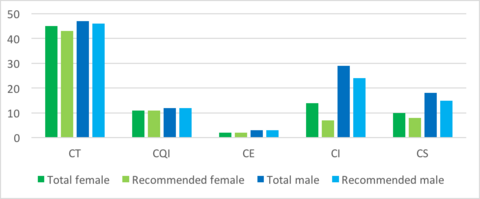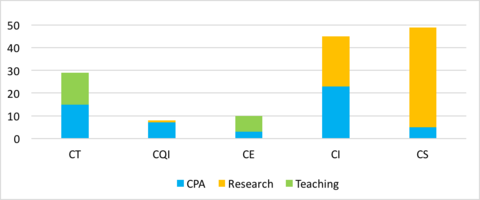Main Second Level Navigation
- Welcome
- Why Toronto?
- History of the Department
- Vision & Strategic Priorities
- Our Leadership
- Our Support Staff
- Location & Contact
- Departmental Committees
- Department of Medicine Prizes & Awards
- Department of Medicine Resident Awards
- Department of Medicine: Self-Study Report (2013 - 2018)
- Department of Medicine: Self-Study Report (2018 - 2023)
- Communication Resources
- News
- Events
Chair's Column: The Evolution of Continuing Faculty Appointment Review – Getting it Right for Everyone

Dr. Gillian Hawker

As you know, all new full-time clinical faculty appointments to the Department of Medicine at the University of Toronto – irrespective of academic rank at appointment - are probationary for three to five years. Continued appointment beyond this time point is contingent upon a successful Continuing Faculty Appointment Review (CFAR).
On October 10, the DoM will be holding its annual CFAR workshop for those undergoing CFAR this year (to attend, RSVP to dom.cfar@utoronto.ca). I know CFAR is top-of-mind for many of our faculty members. Therefore, I thought it would be useful in this Chair’s Column to talk about this initial milestone in the academic life cycle. We’ve also asked some of our faculty members who are recently post-CFAR to reflect on their experiences and to provide some words of wisdom to those who follow in this issue of DoM Matters.
CFAR: What are we looking for?
CFAR is conducted by the CFAR Committee, which is composed of 16-20 senior Department of Medicine faculty members appointed by the Department Chair. Each faculty member up for CFAR is reviewed independently by a primary and secondary reviewer. At review, the contributions of the faculty member are evaluated based on their academic position description (APD), such as clinician teacher or clinician scientist, the Academic Plan completed at appointment, the quality and quantity of their teaching, and their professional behaviour. In essence, reviewers are assessing if the faculty member is:
- Meeting the expectations of their APD and if not, why not? E.g. wrong APD, inadequate mentorship/menteeship, insufficient protected time, or poor time management?
- Has clearly demonstrated teaching effectiveness; and,
- Has demonstrated behaviour consistent with U of T’s code of conduct.
Since the 2013-2014 academic year, the department has conducted 215 continuing faculty appointment reviews of 192 full-time clinical faculty members [94 women & 121 men; 99 clinician-teachers (CT), 25 clinicians in quality and innovation (CQI), five clinician-educators (CE), 53 clinician-investigators (CI), 33 clinician-scientists (CS) and one PhD research scientist (RS)]. Figure 1.
Figure 1: Continuing Faculty Reviews by Position Description from 2014-2018 (n=192)

Over this time period, we have made a number of changes to the CFAR process to improve the CFAR experience and success at review. Specifically, our goals have been to:
- Reduce the work-load involved. Everything is now ‘templated’ and online. If the committee’s initial recommendation is to extend probation, the candidate is given an opportunity to provide additional information before a final recommendation is made. For those who are deemed close to meeting requirements, but not quite there, we have removed the need for a full second review, replacing it instead with submission of a letter outlining how the recommendations have been addressed, with supporting evidence, such as an updated CV.
- Enhance clarity with respect to expectations of faculty members in each APD overall, and specifically at the CFAR review, with respect to scholarship (protected time and productivity), clinical care, teaching and professionalism. We developed and implemented a ‘living document’ – the faculty member’s Academic Plan. The Plan is signed by all key stakeholders and the formal mentor in order to hold all stakeholders accountable if things go off the rails. The Plan is reviewed at faculty appointment by the Department Appointments Committee, who often request minor tweaks or clarification to ensure the Plan is realistic and appropriate. At CFAR, the Plan is reviewed once again and CFAR candidates are asked to reflect on what they said they were going to do and what they have done. We have also expanded the CFAR committee membership to ensure that all position descriptions are well represented. Under the leadership of our Vice Chair for Mentorship, Equity and Diversity, Dr. Sharon Straus, the department’s mentorship program has been amplified to ensure improved mentorship across the academic lifespan, including in the early years of faculty membership.
- Align CFAR with our department’s guiding principles. Consistent demonstration of professional behavior, regardless of academic rank, is now an explicit requirement for successful CFAR. We recently extended CFAR to our senior faculty recruits to ensure they too are assessed against our values and guiding principles.
- Use the CFAR process as a spring board for senior promotion. CFAR committee recommendations are provided to the faculty member and include a recommendation on readiness for senior promotion.
Despite these changes, there is clearly still room for improvement.
Of those who went through their initial CFAR review between 2013-14 and 2017-18 (n=192), 171 were recommended for continuing faculty appointment (89%). Of the 21 re-reviews, 18 were successful, one took a position elsewhere and two did not have their appointment continued. But this doesn’t tell the full story. The success rate for CTs, CEs, and CQIs is pretty much 100%. The occasional teacher has work to do on their teaching effectiveness, but this is generally easily dealt with given an additional year or two and some mentorship.
The story is very different for our CI and CS faculty, as shown below in Figure 2. Of 43 initial CI reviews, 31 were successful (72%); for CS faculty, 23 of 28 were successful at initial review (82%). Although almost all the individuals that were recommended extension of the probationary period were successful at re-review (99%), I have seen first-hand the sense of failure and defeat these faculty members experience when told they hadn’t ‘passed’ the initial review.
Figure 2: Number of faculty members reviewed (total) and recommended for continuing faculty appointment by position description (n=192)

Seeing these data, I wondered if there were other factors besides APD that might be affecting success rates for our CS and CI faculty members. I looked at specialty, hospital, academic rank at appointment (lecturer vs. other) and sex. Of our 181 CI faculty, almost half are in one of three divisions: Medical Oncology (18%), Cardiology (15%) and Hematology (13%) and half are located at UHN (50%). However, after controlling for position description, there were no significant differences in CFAR success rates by hospital, rank or specialty. Within our CI faculty, the numbers of men and women who have gone through CFAR are relatively small – nevertheless, the proportion of women who were successful at their initial review was significantly lower than it was for men (7/14 women and 24/29 men, p=0.03). A potential explanation includes the impact of pregnancy and childbirth on scholarly productivity, although periods of leave are factored into CFAR timing. To better understand why these differences may exist we will be surveying our CS and CI faculty in the coming months.
Figure 3: Total Reviews and Recommended for Continuing Appointment by Sex and Position Description

What are the reasons for extended probation?
The most common reasons for extended probation are the following:
- Insufficient protection of the time allotted for scholarship: CI faculty are particularly vulnerable given their visibility in the clinical realm and the pressures clinicians are currently facing.
- Disproportionate focus on obtaining grants at the expense of publications: CS faculty are most at risk here especially given how tough it is to obtain peer-reviewed funding these days.
- Failure to complete graduate training: This is often a proxy for a mismatch between the faculty member’s APD (CS or CI) with career aspirations. This is why we are not supportive of appointing individuals until such training has been or is about to be completed.
- Inadequate demonstration of teaching effectiveness (quality or quantity): This is particularly difficult for CS faculty, who may have little direct interaction with residents and fellows, and for faculty members in specific ambulatory specialties and emergency medicine.
- Failure to address repeated unprofessional behaviour.
For our clinician scientists, and particularly the basic scientists, most often three years is simply insufficient to establish an independent research program, obtain a peer-review grant and some peer-reviewed first or senior author publications. Invariably, the foundation has been laid, grants have been submitted with promising results and papers are under review. It is simply a matter of time. Conducting CFAR at year four may do the trick.
For our clinician investigators, there are two additional factors that are at play. First, there remains confusion about the CI position description – many senior faculty continue to see this group as ‘mini-scientists’ and are looking for grants and papers at the level of CS faculty. (We removed the requirement for a PI grant from the CI position description back in 2015!) Secondly, there is a failure to recognize that our CI faculty are heterogeneous – while some will go forward for senior promotion based on research excellence, as many if not more will go forward based on excellence in creative professional activities or CPA. Clarifying early on which of these career trajectories is most likely based on the focus of scholarship and career aspirations has not, to date, been incorporated into the academic plan or mentorship process of newly appointed faculty. It should be.
Figure 4: Criteria for Senior Promotion by Position Description (n=141)

How can we do better?
NEW: Pre-CFAR Check-In Meetings
With this background, we have launched a new initiative: the “pre-CFAR” meeting. These meetings, initiated by the appropriate Vice Chair and/or myself, will be scheduled to occur half-way between initial appointment and ‘three-year review’. They are intended to supplement those already taking place between faculty members and their PIC, DDD, and others, and require no formal preparation. With the faculty member’s Academic Plan in hand, the purpose is to check in on how things are going in order to proactively identify issues that may impact timing of and/or success at CFAR. This includes faculty members’ balance of time and time management, clinical activities, teaching (type, quality and quantity), completion of advanced training, research productivity, quality and quantity of mentorship, career satisfaction and work-life integration. These meetings will inform the timing of initial CFAR review for CS and CI faculty members. Specifically, we will determine if CFAR should take place after three or four years on faculty.
To date, Vice Chair, Research, Dr. Mike Farkouh and I have met with about 15 CS and CI faculty members. We think these meetings have been enormously helpful, but would appreciate feedback! We are learning a lot and, I hope, also identifying and addressing barriers to success.
Greater attention to the Annual Activity Review
All full-time DoM members are expected to participate in an Annual Faculty Review to discuss what is and what may not be working to achieve your goals, to ensure you are meeting the expectations of your primary hospital, division and the university, and to ensure success at CFAR and promotion through the ranks. However, given the variability in size of our divisions and hospital departments, the frequency and quality of annual review is not uniform hospitals and divisions. To improve the overall effectiveness of this process, we have developed an Annual Review Checklist to guide these meetings. In brief, in any given year, the following items should be discussed, as appropriate to your position description, career stage and rank:
- Highlights and challenges of the prior academic year & goals for the upcoming year: teaching/education, research, creative professional activities;
- Wellness & work life integration;
- Academic Position Description: alignment with career goals; alignment of position description expectations re teaching (quantity, quality and levels of teaching), scholarship, clinical and administrative activities with your current activities;
- Teaching effectiveness: teaching evaluations – number and UG/PG TES scores;
- Mentorship: quality and quantity, appropriateness to needs;
- Professional Development: leadership or other advanced training
- Career milestones: preparedness for 3-year review & junior/senior promotion;
- Professionalism, citizenship & engagement: formal assessments, participation in hospital, divisional and departmental activities, attendance at rounds, participation on committees;
- Finances: practice plan status, retirement planning, adherence to Hospital policies;
- Adherence to Hospital / University policies regarding conflict of interest and relationships with industry;
- Planned changes in clinical or academic activities (leaves, breaks and retirement plans); and,
- Eligibility for awards: hospital, divisional and departmental.
Faculty members are encouraged to prepare for this meeting. For those of you recently appointed, make sure you review your Academic Plan and reflect on the quality and quantity of your teaching evaluations. Are you on track? If not, why not? What are your priorities for discussion? Irrespective of who conducts the review, make sure that key points discussed and action items are summarized and shared with you, your PIC and hospital and departmental DDDs. This will help ensure we are all on the same page as you with respect to your career plans and expected outcomes.
Helping you to craft your CPA Story
Given that faculty members in all position descriptions are increasingly going forward for promotion on the basis of excellence in CPA, we need to do a much better job of helping you to craft your CPA story. To this end, we incorporated this objective into this year’s New Faculty Orientation and will be holding a workshop under the leadership of Drs. Brian Wong and Ed Etchells to ensure you are all able to convincingly tell us what you do (your focus) and the impact it’s had. For everyone considering senior promotion or pre-CFAR, I strongly encourage you to attend this workshop!
Clarifying early on in one’s career the likely criteria for senior promotion – sustained teaching excellence, excellence in CPA or excellence in research – can be very helpful in determining how you organize your CV and shape your candidate’s statements for CFAR and promotion.
Summary
CFAR may seem like a daunting undertaking, but as some of our faculty who have been through the process have said, it’s a necessary step on the road to promotion, and a valuable time to reflect on your career. I welcome your thoughts about CFAR, and what we can do to improve the experience for everyone. Please email me at g.hawker@utoronto.ca.

